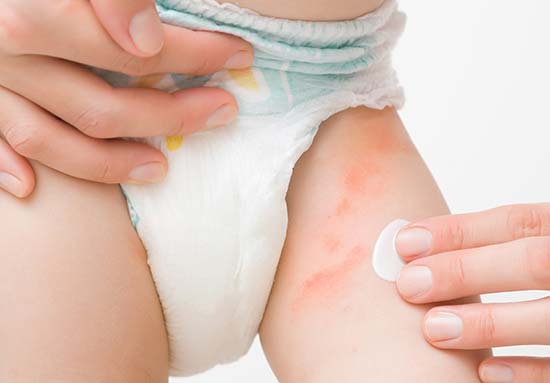Understanding Nappy Rash with White Spots: A Parent’s Guide
Welcome, wonderful parents, to your go-to guide for all things related to nappy rash with white spots! We understand that as a nurturer of a little one, you want nothing but the best for your baby’s tender skin. Nappy rash can be a common concern, but those pesky white spots might have raised your eyebrows in worry. Fear not! Our comprehensive article is here to sprinkle knowledge and peace of mind, making you smile just as much as we aim to make those rashes disappear!
What is Nappy Rash?
Before we dive into the speckled sea of white spots, let’s ensure we’re all aboard the same ship regarding what nappy rash is. Nappy rash, also known as diaper dermatitis, is a skin irritation that can occur in the diaper area. It’s characterized by redness, swelling, and sometimes even tender blisters. Don’t fret, though! It’s quite normal and happens to many babies at some point during their nappy-wearing journey.
Identifying White Spots in Nappy Rash
When it comes to those mysterious white spots amidst a nappy rash, the plot thickens. These spots can be a sign of either a fungal infection, like candidiasis, or might be due to a bacterial infection. It’s essential to differentiate between the two, as treatments will vary. While a spot of worry is understandable, with proper care and treatment, your baby’s skin can return to being as smooth as their cheeky little giggle in no time!
Causes of Nappy Rash with White Spots
Let’s explore the ‘whys’ behind these white spots on your baby’s otherwise peach-perfect bottom:
- Yeast Infections: The warm, moist environment of a nappy is the perfect breeding ground for yeast, particularly Candida albicans, which can lead to white spots amid the rash.
- Bacterial Infections: Sometimes, bacteria like Staphylococcus aureus can cause white spots and additional issues if they gain a foothold in the nappy area.
Initial Steps to Alleviate Nappy Rash with White Spots
Here are some skin-loving steps to take the minute you notice anything amiss:
- Change Nappies More Frequently: Keep your baby’s bottom as dry as possible by changing nappies often.
- Gentle Cleansing: Use plain water or mild, baby-friendly wipes for cleaning. Avoid vigorous rubbing – patting is the way to our happy-baby land!
- Barrier Cream: Protect that delicate derrière with a barrier cream. Look for ones with zinc oxide, which offer a protective layer and are kind on the skin.
- Air Time: As much as practical, let your baby’s bottom breathe. A little air time goes a long way to heal and prevent rashes.
Remember, the above steps are just the beginning. If you notice those white spots sticking around like unwanted guests, don’t hesitate to consult your baby’s pediatrician. They will evaluate your little one and provide a treatment plan to suit their specific needs.
Stay tuned for even more valuable insights, as we will delve deeper into treatments, home remedies, and prevention strategies. Because here, we’re not just about face-value tips; we aim to equip you with all the knowledge you need to become the superhero of nappy rash battles! Let’s turn that frown upside down by putting an end to those bothersome white spots and giving your baby the comfort they deserve.
Your precious bundle’s comfort and happiness is our mission. So buckle up, dear parents, for a journey to clearer skies and smoother bottoms. Keep reading for further information on how to wave goodbye to nappy rash with white spots!

5 Preparatory Tips for Managing Nappy Rash with White Spots
Whether you’re a new parent or an experienced one, being prepared for potential nappy rash with white spots can save you stress and ensure your baby stays comfortable. Here are five things you should know in anticipation:
1. Understand the Risk Factors
Some babies are more prone to nappy rash due to sensitive skin, recent use of antibiotics, or a history of rashes. If your child is at higher risk, being extra vigilant with nappy changes and skin care is even more important.
2. Stock Up on the Essentials
Keep the necessary supplies at hand:
- Gentle, fragrance-free wipes or a soft cloth.
- A water bucket or spray bottle for easy rinsing.
- Zinc oxide barrier cream or ointment.
- A couple of waterproof changing pads for nappy-free time.
- Cotton balls or pads for gentle drying.
3. Create a Comfortable Changing Station
Set up a diaper-changing area that is comfortable for you and your baby. Make sure everything you need is within arm’s reach so you can keep one hand on your child at all times. The spot should be well-lit, clean, and cozy.
4. Know When to See a Doctor
Monitor your child’s skin for signs of infection, like persistent white spots, worsening redness, or pus. These symptoms indicate it’s time to get professional medical advice. Always be ready to consult a pediatrician if you notice any unusual changes.
5. Educate All Caretakers
Ensure everyone who looks after your baby understands their skin care needs. Educating grandparents, babysitters, and daycare staff on the importance of frequent nappy changes and proper skin care helps maintain consistency.
A well-prepped arsenal and knowledge base will keep your baby’s nappy rash with white spots at bay, or at the very least, help you tackle it swiftly and effectively. Now, on to insights about treatment options and home remedies!
Effective Treatments and Home Remedies for Nappy Rash with White Spots
Alongside the preliminary steps already discussed, there are more specific treatments and homely acts of heroism you can enlist to combat those stubborn white spots.
Medicated Creams and Ointments
For a yeast infection, an antifungal cream specifically designed for infants is often the key to success. These creams are usually applied after each nappy change. For bacterial infections, the pediatrician may prescribe an antibiotic ointment. It’s important to follow their guidance closely and never use over-the-counter medications without consulting them first.
Homely Heroes
There’s no place like home, especially when it comes to tender care and treatment. Some parents swear by the powers of:
- Warm baths with mild, baby-friendly soap or just plain water.
- Coconut oil, revered for its antifungal and soothing properties.
- Homemade wipes using gentle ingredients to prevent further irritation.
- Breast milk, which is sometimes used for its natural antibodies (though this is anecdotal and should be discussed with your pediatrician).
When to Reach for Home Remedies
While some home remedies can provide relief, they’re not all suitable for every type of nappy rash or white spots. It’s crucial to confirm the cause with your pediatrician before trying home-based treatments. What’s soothing for simple rashes might not be effective against fungal or bacterial causes.
Armed with an understanding of treatments and home remedies, you’re on your way to becoming a nappy rash ninja! Just remember to keep your pediatrician’s advice in mind and observe your baby’s response to any new treatment or remedy.
Ensuring your little one’s skin is happy and healthy is a challenging but incredibly rewarding journey. With the right knowledge and preparation, you can face any nappy rash battle head-on, white spots and all!
As you navigate the road of parenting, remember that when it comes to nappy rash with white spots, you’re not alone. There’s a whole community of experts and fellow parents to support you. Here’s to clear skies, smooth journeys, and joyous days, free from the worries of nappy rash!
Continue to enrich your nappy rash know-how by staying informed on the latest advice and remedies. Your baby’s bottom will thank you, and those beautiful, uninhibited smiles will be all the reward you need. Keep up the great work, amazing parents!
See more great Things to Do with Kids in New Zealand here. For more information see here
Disclaimer
The articles available via our website provide general information only and we strongly urge readers to exercise caution and conduct their own thorough research and fact-checking. The information presented should not be taken as absolute truth, and, to the maximum extent permitted by law, we will not be held liable for any inaccuracies or errors in the content. It is essential for individuals to independently verify and validate the information before making any decisions or taking any actions based on the articles.




